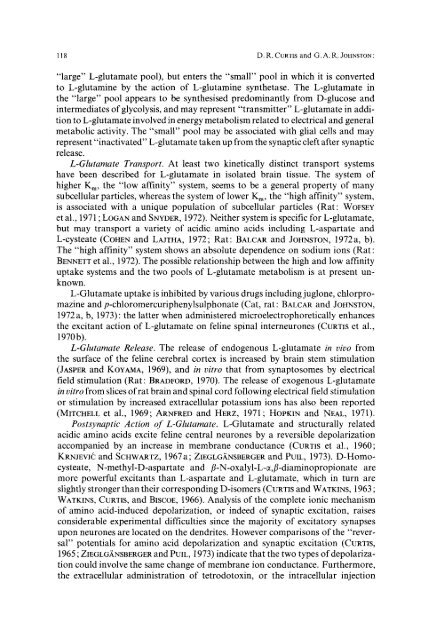Amino acid transmitters in the mammalian central nervous system
Amino acid transmitters in the mammalian central nervous system
Amino acid transmitters in the mammalian central nervous system
Create successful ePaper yourself
Turn your PDF publications into a flip-book with our unique Google optimized e-Paper software.
118 D.R. CURTIS and G. A. R. JOHNSTON"<br />
"large" L-glutamate pool), but enters <strong>the</strong> "small" pool <strong>in</strong> which it is converted<br />
to L-glutam<strong>in</strong>e by <strong>the</strong> action of L-glutam<strong>in</strong>e syn<strong>the</strong>tase. The L-glutamate <strong>in</strong><br />
<strong>the</strong> "large" pool appears to be syn<strong>the</strong>sised predom<strong>in</strong>antly from D-glucose and<br />
<strong>in</strong>termediates of glycolysis, and may represent "transmitter" L-glutamate <strong>in</strong> addition<br />
to L-glutamate <strong>in</strong>volved <strong>in</strong> energy metabolism related to electrical and general<br />
metabolic activity. The "small" pool may be associated with glial cells and may<br />
represent "<strong>in</strong>activated" L-glutamate taken up from <strong>the</strong> synaptic cleft after synaptic<br />
release.<br />
L-Glutamate Transport. At least two k<strong>in</strong>etically dist<strong>in</strong>ct transport <strong>system</strong>s<br />
have been described for L-glutamate <strong>in</strong> isolated bra<strong>in</strong> tissue. The <strong>system</strong> of<br />
higher Km, <strong>the</strong> "low aff<strong>in</strong>ity" <strong>system</strong>, seems to be a general property of many<br />
subcellular particles, whereas <strong>the</strong> <strong>system</strong> of lower Km, <strong>the</strong> "high aff<strong>in</strong>ity" <strong>system</strong>,<br />
is associated with a unique population of subcellular particles (Rat: WOVSEY<br />
et al,, 1971 ; LOGAN and SNYDER, 1972). Nei<strong>the</strong>r <strong>system</strong> is specific for L-glutamate,<br />
but may transport a variety of <strong>acid</strong>ic, am<strong>in</strong>o <strong>acid</strong>s <strong>in</strong>clud<strong>in</strong>g L-aspartate and<br />
L-cysteate (COHEN and LAJTHA, 1972; Rat: BALCAR and JOHNSTON, 1972a, b).<br />
The "high aff<strong>in</strong>ity" <strong>system</strong> shows an absolute dependence on sodium ions (Rat:<br />
BENNETT et al., 1972). The possible relationship between <strong>the</strong> high and low aff<strong>in</strong>ity<br />
uptake <strong>system</strong>s and <strong>the</strong> two pools of L-glutamate metabolism is at present unknown.<br />
L-Glutamate uptake is <strong>in</strong>hibited by various drugs <strong>in</strong>clud<strong>in</strong>g juglone, chlorpromaz<strong>in</strong>e<br />
and p-chloromercuriphenylsulphonate (Cat, rat: BALCAR and JOHNSTON,<br />
1972 a, b, 1973): <strong>the</strong> latter when adm<strong>in</strong>istered microelectrophoretically enhances<br />
<strong>the</strong> excitant action of L-glutamate on fel<strong>in</strong>e sp<strong>in</strong>al <strong>in</strong>terneurones (CURTIS et al.,<br />
1970b).<br />
L-Glutamate Release. The release of endogenous L-glutamate <strong>in</strong> vivo from<br />
<strong>the</strong> surface of <strong>the</strong> fel<strong>in</strong>e cerebral cortex is <strong>in</strong>creased by bra<strong>in</strong> stem stimulation<br />
(JASPER and KOYAMA, 1969), and <strong>in</strong> vitro that from synaptosomes by electrical<br />
field stimulation (Rat: BRADFORD, 1970). The release of exogenous L-glutamate<br />
<strong>in</strong> vitro from slices of rat bra<strong>in</strong> and sp<strong>in</strong>al cord follow<strong>in</strong>g electrical field stimulation<br />
or stimulation by <strong>in</strong>creased extracellular potassium ions has also been reported<br />
(MITCHELL et al., 1969; ARNFRED and HERZ, 1971 ; HOPKIN and NEAL, 1971).<br />
Postsynaptie Action of L-Glutamate. L-Glutamate and structurally related<br />
<strong>acid</strong>ic am<strong>in</strong>o <strong>acid</strong>s excite fel<strong>in</strong>e <strong>central</strong> neurones by a reversible depolarization<br />
accompanied by an <strong>in</strong>crease <strong>in</strong> membrane conductance (CuRTlS et al., 1960;<br />
KRNJEVI~ and SCHWARTZ, 1967a, ZIEGLG~,NSBERGER and PUIL, 1973). D-Homocysteate,<br />
N-methyl-D-aspartate and fl-N-oxalyl-L-c~,fl-diam<strong>in</strong>opropionate are<br />
more powerful excitants than L-aspartate and L-glutamate, which <strong>in</strong> turn are<br />
slightly stronger than <strong>the</strong>ir correspond<strong>in</strong>g D-isomers (CURTIS and WATKINS, 1963 ;<br />
WATKINS, CURTIS, and BISCOE, 1966). Analysis of <strong>the</strong> complete ionic mechanism<br />
of am<strong>in</strong>o <strong>acid</strong>-<strong>in</strong>duced depolarization, or <strong>in</strong>deed of synaptic excitation, raises<br />
considerable experimental difficulties s<strong>in</strong>ce <strong>the</strong> majority of excitatory synapses<br />
upon neurones are located on <strong>the</strong> dendrites. However comparisons of <strong>the</strong> "reversal"<br />
potentials for am<strong>in</strong>o <strong>acid</strong> depolarization and synaptic excitation (CURTIS,<br />
1965; ZIEGLG,g, NSBERGER and PUIL, 1973) <strong>in</strong>dicate that <strong>the</strong> two types of depolarization<br />
could <strong>in</strong>volve <strong>the</strong> same change of membrane ion conductance. Fur<strong>the</strong>rmore,<br />
<strong>the</strong> extracellular adm<strong>in</strong>istration of tetrodotox<strong>in</strong>, or <strong>the</strong> <strong>in</strong>tracellular <strong>in</strong>jection













